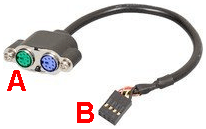11
1
In the below image (from here), the "left" end (which I have labeled "A") is clearly two PS/2 ports.
What is the "right" end (which I have labeled "B")?
Does it connect directly to a motherboard?

The above is apparently Lenovo part number 43N9149, but I haven't been able to find an actual specification sheet for this part -- only third-party seller listings on Amazon, eBay, and the like.
ADDENDUM
I need to be able to use a PS/2 mouse with a Lenovo ThinkStation that I am considering. The particular system I am considering does not have a built-in PS/2 port, but Lenovo sells the above part as an add-on. The problem is, on my existing desktop (not Lenovo) I have tried external USB to PS/2 adapters (dongles) from third-parties, and I have experienced a significant latency issue when I connect a mouse to it. I mean, cursor movement on my screen significantly and noticeably lags the physical movement of my mouse with such external dongles. I'm hoping that the "B" end above has a faster connection than an external USB connection would have.


1Thats totally not true @mins! USB and PS/2 are entirely different signals. All Devices that work with passive converters support both signals! You can't use any device supporting only PS/2 in a USB port with a passive "converter". – Josef says Reinstate Monica – 2015-06-15T06:59:46.340
@Josef. I stand corrected. This is the device which senses the host it is connected to, and send the proper signal. Thanks for pointing it out.
– mins – 2015-06-15T07:42:39.577Do you intend to unplug/replug the PS/2 mouse to this connector? (Your phrase "when I connect a mouse to it" prompts this question. I hope you do not mean that you (dis-)connect the mouse while powered.) – Eric Towers – 2015-06-15T13:45:26.953